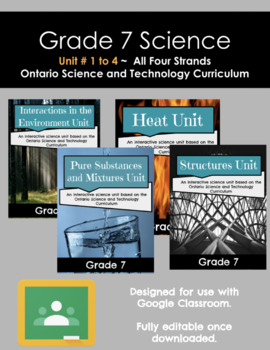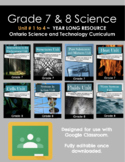Year Long Gr. 7 Science Units (Ontario Based Curriculum, Google Classroom Ready)
- Zip
What educators are saying
Products in this Bundle (4)
Also included in
- In this bundle, I have added all four Grade 7 Science and Technology Units. These lessons were made as a resource for my students "learning from home". Each lesson is was created with Ontario Science and Technology curriculum in mind.Unit 1 ~ Interactions in the Ecosystem (Nine Interactive Lessons)LPrice $93.60Original Price $104.00Save $10.40
Description
In this bundle, I have added all four Grade 7 Science and Technology Units. These lessons were made as a resource for my students "learning from home". Each lesson is was created with Ontario Science and Technology curriculum in mind.
Unit 1 ~ Interactions in the Ecosystem (Nine Interactive Lessons)
Lesson Overviews:
Lesson 1 - What is an Ecosystem?
Ecosystems are complex systems where living things interact with other living things and non-living things. Let’s learn all about it in this lesson!
Lesson 2 - What are producers?
Producers are essential biotic elements of an ecosystem. Let’s examine their role in these environments!
Lesson 3 - What are consumers?
Consumers are biotic elements found in an ecosystem. There are various types of consumers and each has their own role. Let’s examine consumers in various environments!
Lesson 4 - Types of Ecosystems Around the World
Every ecosystem has a community of plants and animals that have common characteristics for the environment they exist in. Let’s examine the different types of ecosystems found around the world!
Lesson 5 - Energy Transfers
Some of the light and heat that flows from the Sun is absorbed by producers. Through photosynthesis, the producers change that energy into sugars that they use for foods. Consumers then eat the producers, therefore transferring this energy to other organisms. Let’s examine this process!
Lesson 6 - Why do ecosystems change?
Ecosystems are constantly changing and adapting to the world that we live in today. Let’s examine how these changes affect the environment big and small.
Lesson 7 - Sustainability
An ecosystem is described as being sustainable when it can maintain a balance of needs and resources over time. In this lesson, let’s examine how ecosystems continue to sustain itself naturally and with human interaction.
Lesson 8 - Succession, Recovery, and Renewal
What happens when an environment suddenly changes due to natural disasters or human intervention? Can the ecosystem recover and renew itself? Let’s examine the roles or succession, recovery, and renewal as it relates to these changes.
Lesson 9 - Assessing Human Impact
Human communities benefit from technology. Inventions and human-engineered materials have improved our survival and quality of life, however, they also affect local ecosystems. Many of these technologies have damaged ecosystems shared by all. Let’s examine how we can make changes to help reduce our impact!
Unit 2 ~ Form and Functions: Structures Unit (Five Interactive Lessons)
Lesson Overview:
Lesson One - Classification of Structures
Just about everything you see is a structure: buildings, cars, trees, bicycles, your body, and so on. In this lesson, let’s explore how structures can be classified.
Lesson 2 - Forces that act on Structures
Structures are designed to withstand the forces that act on them. Some of those forces come from the outside of the structure, whereas, some come from within. In this lesson, let’s explore these forces.
Lesson 3 - Describing Forces
In this lesson, we will investigate the factors that determine the ability of a structure to support a load.
Lesson 4 - Designing for Safety
Structures are required to withstand several forces. In this lesson, we will investigate how structures are built to be safe.
Lesson 5 - Stability in Structures
Stability is the ability of a structure to maintain or resume its position when an external force has been applied to it. In this lesson, we will investigate how structures are designed for strength, stability, function, and form.
Build Your Own Bridge - A culminating task
In this activity, you will be designing and creating your own bridge and using all of the knowledge that you have gained to explain the forces that act on your structure.
Unit 3 ~ Pure Substances and Mixtures (Six Interactive Lessons)
Lesson Overview:
LESSON # 1 ~ The States of Matter
Just about everything you see is made up of matter. Matter is anything that has mass and takes up space. In this lesson, let’s explore the theory of matter and changes of state.
LESSON # 2 ~ Classifying Matter
Matter can be grouped in different ways. It can be classified as a solid, liquid, or a gas. It can also be classified by what it is made up of. In this lesson, we will explore the composition of matter; pure substances and mixtures.
LESSON # 3 ~ Solutions: Concentration and Solubility
In this lesson, we will examine the concentration and solubility of various solutions. We will also explore the difference between solutes and solvents.
LESSON # 4 ~ Separating Solutions and Mechanical Mixtures
In this lesson, we will examine the methods used to separate various solutions and mechanical mixtures.
LESSON # 5 ~ Impacts of Solutions and Mechanical Mixtures on the Environment
In this lesson, we will identify industrial applications of the processes used to separate mixtures and solutions. We will also assess the impacts on society and the environment of different industrial methods of separation of these substances.
LESSON # 6 ~ Disposal of Pure Solutions and Mixtures on the Environment
In this lesson, we will investigate the negative impacts of disposing of industrial substances and mixtures in the natural environment. We will explore some of the by-products of industrial processes, as well as, the environmental impacts of releasing raw sewage into waterways.
Unit 4 ~ Heat Unit (Six Interactive Lessons)
Lesson Overview:
Lesson 1 - Energy Transformation
Heat is a form of energy. This energy can be changed from one form to another. Let’s learn all about it in this lesson!
Lesson 2 - Heat Production
We use a variety of heat sources on a daily basis. Let’s examine these sources and their impact on the environment!
Lesson 3 - Heat Transfers and Loss
When heat transfer occurs, the energy is carried through or across from one solid, liquid or gas to another.
Lesson 4 - Heat Affects the Air Around Us
Weather and climate are largely affected by convection currents and radiant energy. Let’s examine how these types of energy affect the air around us on a daily basis.
Lesson 5 - Heat Affects Land
The Earth is made of several layers. These layers were formed as a result of heat. In this lesson, let’s examine how heat causes changes our the Earth.
Lesson 6 - Human Activities produce Heat
Heat is often released into the environment when energy is transformed. Let’s examine how heat pollution of land, water, and the atmosphere affect our world!
Disclaimer: I am still updating a few units to include "student answer slides" and "check-ins". Once they have been updating, you will be notified to download the unit PDF file.



